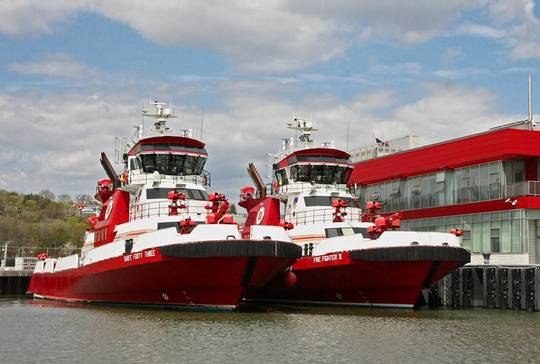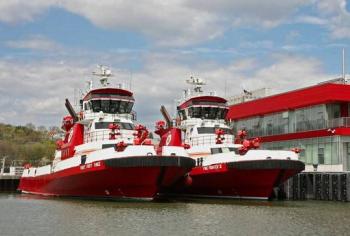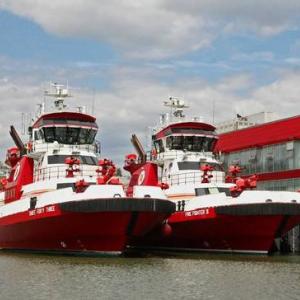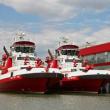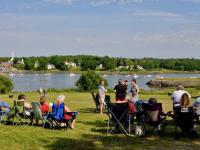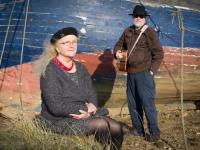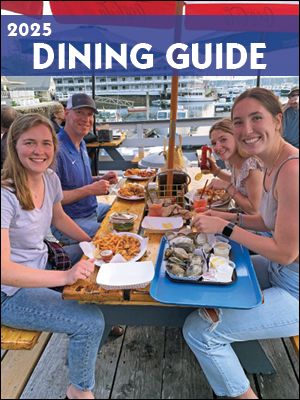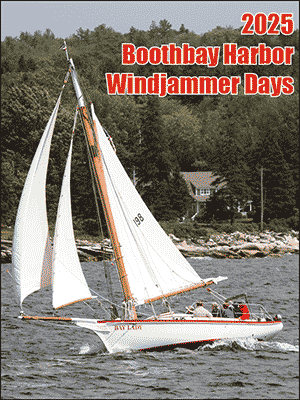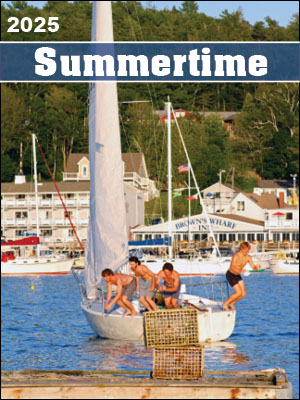Former Boothbay boatbuilder relates 9-11 fire boat stories
I started work at Eastern Shipbuilding 23 years ago this coming Monday, which was the Monday after September 11th. In that time I’ve been associated with the construction of over 50 ships, but the finest vessels I’ll ever build were two fire boats for the Fire Dept. of the City of New York.
We signed a contract for these boats in the late fall of 2007. Gorden Anderson’s grandfather, Mike Yriondo, was our contracts administrator, and personally attended the bid opening in late summer of 2007. It became obvious that the Fire Department had not counted on the cost and that they probably didn’t have enough money to build the two boats.
After the other yards left, he said “I think you have a problem, and I can help you.” He proposed several ideas to get the cost reduced until they had a number both parties found mutually agreeable.
On the morning of Sept 11th, 2001, the FDNY had two large fire boats in Service. Marine 1‘s John D McKean, and Marine 9’s Fire Fighter.
The Fire Fighter was the oldest and largest at 134’, built in 1938, she could pump 20,000 gpm.
The McKean at 130’ was built in 1954, and capable of pumping 18,000 gpm.
A 3rd boat had been sold in 1995 to a group of private individuals who wanted to make her a functioning museum fire boat display. The John J Harvey was built in 1931 and capable of pumping 19,000 GPM if everything was functioning. News articles of the time about Harvey emphasized how modern she was based on having gasoline engines and not steam.
9-11 response
The first plane struck the North Tower at 8:45. The shift changed in most fire houses at 8:30 so most people were just coming to work or leaving to go home. The fire boat McKean got underway and nosed in along the seawall at Liberty Street just seaward of the WTC. People were being evacuated from the area and were moving toward the shore to find a way out.
The crew quickly decided to start evacuating people across the river to New Jersey and filled up with about 250 people and proceeded to the New Jersey side of the river.
At 9:10, the second plane hit the south tower, and a call went out for more units. The Fire Fighter immediately got underway from Staten Island and made her way up to the Battery. Both boats made several trips shuttling people across the river. Many of whom were injured and in shock.
Marine 1’s Captain Metcalf had stayed behind and walked up to the command center and was standing in the lobby of the south tower waiting for orders from the chief when it collapsed. He was one of the few people that was rescued.
The largest evacuation in history, by water, up to this point, was the evacuation of 338,000 British soldiers from Dunkirk, France in 1940. England sent every available boat to rescue its Army and bring them home. Most vessels were small privately owned boats that were manned by volunteers who recognized a need and wanted to do their part.
This noble record was broken on Sept 11th. Shortly after the collapse of the south tower, all bridges and tunnels to Manhattan were closed. Both fire boats continued to evacuate people but were being overwhelmed. The USCG put out an urgent request for any available boats in the Harbor to immediately come assist. Ferries, pilot boats, tugs and many personal boats all converged on the Battery and began the largest water evacuation in world history. Over 150 vessels manned by over 600 sailors evacuated over half a million people.
The North Tower collapsed at 10:28. On the McKean’s next return trip, the crew were met by several firemen telling them that when the towers collapsed, they had severed the water mains on the lower end of the island, and they had no water. The McKean quickly made up to the Seawall at the foot of Albany Street and began stretching hoses up toward the remaining trucks near the trade center and were eventually able to start supplying four fire engines.
The Fire Fighter quickly did the same thing down around Vesey Street and began supplying five pumpers near WTC 6 which was burning.
The retired fire boat John J Harvey also had arrived to volunteer and had taken a load of people off. On their return, they were requested to pull in next to the McKean and commence pumping operations as well.
The Harvey pumped for about 80 hours, before her old machinery gave out.
The Fire Fighter pumped non-stop for 255 hours supplying over 91 million gallons of seawater.
The McKean pumped for 386 hours and provided over 104 million gallons of seawater.
340 front line firemen were killed when the towers collapsed along with two paramedics and the FDNY Chaplain, Father Michael Judge, making 343 in all.
The story of one family in particular stands out to me through personal connection. My friend Joe Stark had just come to work as chief engineer on the McKean that morning, His younger brother Jeffery had just reported to his Brooklyn Firehouse at Engine 230, and their older brother John, had just been relieved at Engine 75 in the Bronx and was on his way home.
About the time Joe was responding in the fire boat McKean, Jeffery arrived on site in Engine 230, and except for the engineer, the crew began climbing the stairs in the south tower. John turned around as soon as he learned what was happening and returned to help. Both Joe and John survived, but Jeffery did not. The engineer was the only man of the engine 230 crew that survived, as was the case with so many other fire houses.
I was asked to come here and talk to you about the fire boats Eastern Shipbuilding built, but I wanted you to hear all of that first as groundwork for the rest of my story.
After Mike Yriondo, Gordon’s grandfather worked out the contract with the FDNY for the two new boats, we commenced design work to bring their design requirements to fruition. The chiefs soon introduced me to the newly retired chief engineer of the McKean, Joe Stark, who would move here and be our on-site owner’s representative, and to become when of the best friends I’ve ever had.
Their design requirements were not simple and required a great deal of engineering to be accomplished. The boats were to be 140’ x 36’ and draw no more than 9’, with a top speed of at least 20 knots, and capable of pumping 50,000 gpm with all four 2000 hp engines pumping, and with each pump capable of producing 12,500 gpm.
They have 11 water cannons which include 1 17,000 GPM on the bow 6, 6000 gpm and 4 2000 gpm as well as a hydraulic tower crane ladder unit with a 750 GPM monitor on top. Other requirements were to be able to pump a 16” column of water 5 miles inland and pump a 8” column of water 350 feet into the air to provide water to bridge mounted deluge systems to protect the major bridges in the area should a ship catch fire beneath them.
They have a ballast tank in the bow that could be flooded to bring the bow of the boat down to the level of a sea wall or a Ferry should they need people need to be evacuated, as well as a swim platform on the stern to conduct water rescues from another boat or an airplane that had to land on the water.
Engineering was well underway, and we commenced construction in the summer of 2008. The second boat started about 6 months later. The Miracle on the Hudson happened on January 15th of 2009 when a US Airways commercial flight had to land on the Hudson River shortly after takeoff. All 155 people on board were rescued by the old fire boats and several other commercial boats who came to the rescue. I got a call from Chief Segall the next day, telling me I needed to hurry up.
The FDNY maintenance shop at the Brooklyn Navy Yard hand cut the letters for the name from World Trade Center steel for the shipyard to install.
We launched the first boat on September 11th of 2009, and It was commissioned in New York on September 11th, 2010 replacing the McKean at Marine 1. The FDNY now had the newest, largest, most advanced and highest pumping capacity fire boat ever built and has yet to be surpassed.
The Fire Fighter II was delivered on Dec 7th, 2010 and replaced the Fire Fighter at Marine 9. I turned her over into the very capable hands of Captain John Stark at Marine 9, Joe’s older brother.
The fire boats were a true family project for the Stark Brothers, and for me as well. I’m from Maine originally and am the 8th generation in my family to build ships, including a fire boat for the City of Portland back in the 30’s built by my great-grandfather.
In closing, I’d like to point out the immense dedication and expertise it took for the crews of those old boats to keep them in working order as long as they did, especially with the small budget they were given.
I’d also like to invite the students here to investigate shipbuilding as a career path. This area has a long history of it, and keeping our young people here and providing them with a lucrative career is of great interest to the D’Isernia family who own the yard as well as our community overall. Brian D’Isernia started building boats here in the ’70s, and the yard currently employs around 1,200 employees at locations in Panama City, Allenton and Port St. Joe.
It's difficult to go to any port in the U.S. now, and not see an Eastern Shipbuilding built boat.
Thank you.

